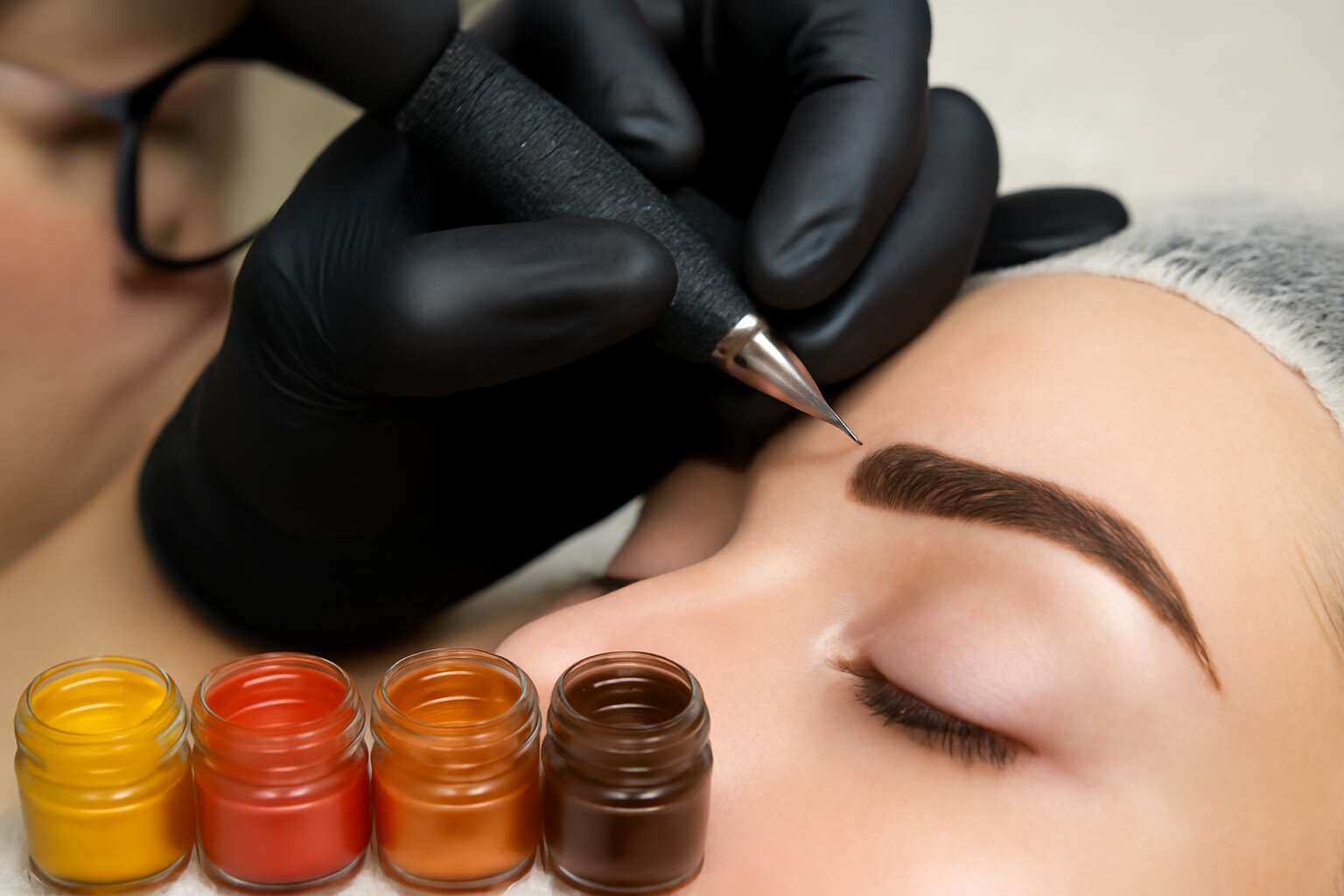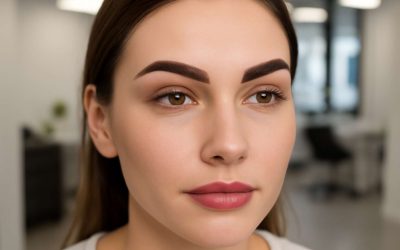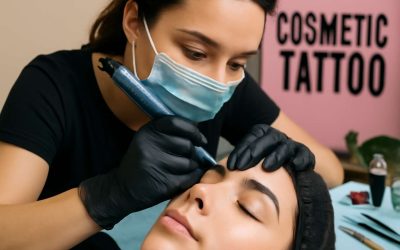Understanding Cosmetic Tattoo Ink
What Is Cosmetic Tattoo Ink?
Cosmetic tattoo ink is the secret behind seemingly effortless beauty transformations, but what exactly makes it so special? Unlike traditional ink, cosmetic tattoo ink is specially formulated to blend seamlessly with skin, creating a natural, long-lasting enhancement. When expertly applied, it can redefine features with precision and subtlety, giving clients a boost of confidence that lasts for years.
This specialized ink is designed to withstand the daily rigors of South Africa’s vibrant climate, resisting fading and discoloration. Its unique composition ensures safety and vibrancy, whether used for eyebrows, lips, or eyeliners. The quality of cosmetic tattoo ink directly impacts the final result, making it a critical element in achieving flawless, natural-looking enhancements that stand the test of time.
For those exploring cosmetic tattooing, understanding the qualities of cosmetic tattoo ink reveals why it plays such a vital role in the art of permanent makeup. From color retention to skin compatibility, every drop holds the power to transform appearances with a touch of artistry and precision.
History and Evolution of Cosmetic Tattooing
The history of cosmetic tattoo ink is a testament to humanity’s relentless pursuit of beauty and permanence. From rudimentary pigment applications in ancient Egypt to the sophisticated formulations of today, this art form has evolved dramatically. It’s fascinating to consider how early civilizations used natural dyes to enhance their features, laying the groundwork for modern techniques. Today, cosmetic tattoo ink is the culmination of centuries of experimentation, blending artistry with scientific innovation to produce shades that mimic natural skin tones and features.
This evolution reflects not only technological advancement but also a deeper understanding of human psychology and the desire for effortless beauty. As cosmetic tattooing gained popularity, especially in vibrant climates like South Africa, the importance of durable, skin-compatible cosmetic tattoo ink became paramount. The art has transformed from mere decoration to a precise, almost existential act of self-expression—an enduring reflection of identity etched into the skin.
In the journey from ancient pigments to contemporary cosmetic tattoo ink, one can observe a shift from rudimentary color applications to highly specialized inks designed for longevity and safety. The modern cosmetic tattoo artist employs a nuanced palette, often choosing from a carefully curated selection of shades to achieve natural, subtle enhancements. This progression underscores the importance of quality cosmetic tattoo ink in shaping not just appearances but also personal confidence and self-awareness.
How Cosmetic Tattoo Ink Differs from Traditional Tattoo Ink
Cosmetic tattoo ink isn’t just your average pigment; it’s a carefully crafted elixir designed to complement the delicate canvas of human skin. Unlike traditional tattoo ink, which is primarily used for body art and can withstand decades of wear, cosmetic tattoo ink is formulated for subtlety and precision. Its primary purpose is to enhance natural features with a gentle touch, ensuring a seamless blend with skin tones that can vary from person to person.
One of the most fascinating differences lies in the composition. Cosmetic tattoo ink is often made with hypoallergenic pigments that are optimized for the face’s sensitive areas. This specialization allows for a more natural, enduring result, while traditional tattoo ink’s durability and boldness are not always suitable for facial features. As a result, cosmetic tattoo ink must strike a delicate balance—lasting enough to provide long-term beauty but gentle enough to maintain skin health and safety.
In essence, the artistry of cosmetic tattoo ink lies in its ability to produce shades that mimic natural skin tones and features. Whether used for eyebrows, eyeliner, or lips, the ink’s unique formulation ensures that the enhancements are subtle yet impactful—transforming everyday beauty routines into effortless elegance. This tailored approach underscores the importance of choosing the right cosmetic tattoo ink for a flawless, lasting result that feels as natural as it looks.
Types of Cosmetic Tattoo Ink
Mineral-Based Inks
When it comes to cosmetic tattoo ink, mineral-based options stand out for their natural origins and gentle profile. Unlike synthetic inks, mineral-based inks are composed of finely ground natural minerals, offering a softer and more skin-friendly alternative. These inks are particularly popular among clients with sensitive skin or those seeking a more organic approach to permanent makeup.
One of the key advantages of mineral-based cosmetic tattoo ink is its vibrant, long-lasting pigmentation without the risk of harsh chemical reactions. The pigments tend to fade more gracefully over time, reducing the need for frequent touch-ups. Furthermore, mineral-based inks are less likely to cause allergic reactions, making them a safe choice for many.
In South Africa, the trend towards natural and holistic beauty is reflected in the increasing demand for mineral-based cosmetic tattoo ink. These inks embody a more conscious approach to beauty enhancement, aligning well with modern preferences for safer, more sustainable cosmetic procedures. The choice of mineral-based inks ensures a balance between durability and skin health — a vital consideration for both practitioners and clients alike.
Organic and Botanical Inks
Among the diverse spectrum of cosmetic tattoo ink, organic and botanical inks are gaining remarkable traction, especially in South Africa’s vibrant beauty industry. These inks harness the power of nature, combining plant-derived pigments with a philosophy rooted in purity and sustainability. Such formulations appeal to clients who seek a more harmonious relationship with their beauty routines, emphasizing eco-friendly and skin-conscious choices.
Unlike traditional synthetic pigments, organic and botanical cosmetic tattoo ink offers a softer, more nuanced pigmentation that tends to fade gracefully over time. This characteristic makes them particularly attractive for those wary of harsh chemicals or allergic reactions. The natural hues often mirror the shades found in nature—muted browns, gentle pinks, and earthy tones—creating a subtle yet striking enhancement.
Incorporating these inks into your practice means aligning with the growing movement toward holistic wellness. They embody a conscious approach to beauty, emphasizing not just aesthetics but also the health of the skin. When selecting cosmetic tattoo ink, practitioners increasingly turn to organic and botanical options, as they offer a harmonious blend of durability, safety, and sustainability.
Synthetic Pigments
When it comes to cosmetic tattoo ink, the spectrum of options is as diverse as South Africa’s vibrant culture. Among the most common choices are synthetic pigments, which have long held a prominent place in the industry. These inks are formulated with a variety of chemically synthesized dyes designed for longevity and vibrancy. Their durability makes them an attractive option for clients seeking bold, lasting results.
However, the world of cosmetic tattoo ink isn’t limited to just synthetic options. For those with a penchant for purity and safety, mineral-based inks and organic and botanical inks offer compelling alternatives. These formulations often contain pigments derived from naturally occurring minerals or plant extracts, making them a favorite among eco-conscious clients. The subtlety of natural hues in organic and botanical inks ensures a more delicate, fade-friendly effect, perfectly suited for nuanced beauty enhancements.
In selecting the ideal cosmetic tattoo ink, practitioners often consider the following factors: color stability, safety profile, and how well the pigment integrates with the skin. Whether choosing synthetic or natural, the goal remains the same — delivering a flawless, enduring finish that celebrates individual beauty with finesse. Ultimately, the choice of cosmetic tattoo ink reflects a commitment to quality, safety, and client satisfaction in a rapidly evolving industry.
Key Ingredients in Cosmetic Tattoo Ink
Common Pigments Used
When it comes to cosmetic tattoo ink, understanding its key ingredients is essential for achieving flawless results that stand the test of time. Unlike traditional tattoo ink, cosmetic tattoo ink is carefully formulated to ensure safety, longevity, and a natural appearance. The pigments used are typically designed to blend seamlessly with skin tones, creating a subtle enhancement rather than a dramatic change.
Common pigments used for cosmetic tattoo ink include iron oxides, titanium dioxide, and various organic dyes. Iron oxides are prized for their stability and wide range of shades, from warm browns to cool blacks. Titanium dioxide acts as a whitening agent, providing opacity and brightness to the pigments. Organic dyes, often derived from botanical sources, offer vibrant and versatile hues suitable for lips and brows. These ingredients are selected with precision to prevent unwanted color migration and fading over time, ensuring clients enjoy beautiful results for years to come.
For those curious about the composition of cosmetic tattoo ink, it’s helpful to know the different types of pigments available:
- Mineral-based pigments
- Organic and botanical inks
- Synthetic pigments
This diverse palette allows practitioners to customize treatments based on individual skin tones and preferences, making cosmetic tattoo ink a truly artful medium. The careful selection of key ingredients guarantees not only aesthetic excellence but also safety and durability, which are paramount in this growing field.
Carrier Liquids and Stabilizers
Carrier liquids and stabilizers are the unsung heroes of cosmetic tattoo ink. They ensure the pigment particles stay evenly suspended, providing consistency during application and longevity afterward. A well-formulated carrier liquid enhances pigment brightness and minimizes migration, resulting in a natural look that lasts. Additionally, stabilizers help maintain the integrity of the ink, preventing premature fading or discoloration.
Most cosmetic tattoo ink uses a combination of distilled water, glycerin, or alcohol as carrier liquids. These ingredients work together to improve flow and reduce the risk of clumping. Stabilizers, such as biopolymers or certain silica derivatives, keep the pigment particles stable over time, safeguarding the ink’s quality. This careful balance ensures clients walk away with flawless, durable results that look stunning for years.
- Distilled water for purity and consistency
- Glycerin for smooth application and moisture retention
- Alcohol-based solutions for quick drying and sterilization
Understanding these key ingredients highlights why premium cosmetic tattoo ink stands out in safety, stability, and aesthetic performance. They are vital to delivering predictable, beautiful results in every treatment session!
Safety and Non-Toxic Formulations
When it comes to cosmetic tattoo ink, safety isn’t just a buzzword—it’s the foundation of every flawless, long-lasting result. Recent studies reveal that over 70% of clients prioritize non-toxic formulations, craving beauty without risking their health. That’s where key ingredients in cosmetic tattoo ink come into play, ensuring each pigment is as safe as it is stunning.
High-quality cosmetic tattoo ink features a careful blend of ingredients designed to minimize risks. Distilled water, for example, guarantees purity and consistency, preventing impurities from sneaking into the skin. Glycerin offers a smooth application while locking in moisture, making sure the pigment settles beautifully. Alcohol-based solutions, on the other hand, facilitate quick drying and sterilization, reducing the chance of contamination.
Furthermore, reputable brands often incorporate stabilizers such as biopolymers or silica derivatives. These components are crucial—they keep pigment particles stable over time, preventing premature fading or discoloration. Understanding these key ingredients helps professionals select cosmetic tattoo ink that’s both safe and effective, delivering predictable and durable results every time.
Choosing the Right Cosmetic Tattoo Ink
Factors to Consider
Choosing the right cosmetic tattoo ink is akin to selecting the perfect shade in a shadowed gallery—each hue must resonate with the soul’s true essence. When considering cosmetic tattoo ink, one must delve into the depths of its composition, seeking pigments that promise longevity without sacrificing safety. The allure of vibrant, enduring results hinges on the quality of the ink’s ingredients, from mineral-based options to synthetic pigments.
In South Africa, where sunlight dances fiercely upon the skin, the importance of selecting a cosmetic tattoo ink that resists fading becomes even more crucial. Factors such as the ink’s stability, biocompatibility, and safety profile should guide every choice. Remember, the integrity of your craft depends on the purity of the ink, ensuring that beauty remains both haunting and everlasting.
Popular Color Choices for Eyebrows, Eyeliner, and Lips
Choosing the right cosmetic tattoo ink is a dance between artistry and science, especially in a climate as fierce as South Africa’s. The palette of popular color choices for eyebrows, eyeliner, and lips must not only complement individual features but also withstand the relentless sun’s glare. Vibrant, long-lasting cosmetic tattoo ink often hinges on carefully selected pigments that resist fading and maintain their integrity over time.
For eyebrows, shades like soft browns and taupes offer natural depth, while darker hues provide a more defined look. When it comes to eyeliner, deep blacks and rich browns are timeless, yet some opt for subtle charcoal to add dimension. Lips benefit from a spectrum of reds, pinks, and mauves—each chosen to mirror personal style and skin tone. The key is to select cosmetic tattoo ink that balances safety with durability, ensuring that beauty remains both captivating and resilient in the South African sun.
Application Techniques and Cosmetic Tattoo Ink
Preparation and Mixing
Mastering the art of cosmetic tattooing hinges on precise application techniques and meticulous preparation of cosmetic tattoo ink. The consistency of your ink not only influences the final aesthetic but also impacts healing and longevity. A well-prepared cosmetic tattoo ink is crucial for achieving uniform pigment distribution, ensuring the client’s confidence in your craft.
When mixing cosmetic tattoo ink, the goal is to attain a smooth, creamy consistency that allows for effortless application. This often involves blending different pigment shades or diluting the ink with carrier liquids to customize the hue and saturation. For optimal results, many artists prefer using a palette to blend pigments gradually, avoiding abrupt shifts in tone. The process demands patience and an eye for subtle color nuances, transforming a simple mixture into a personalized palette that complements each client’s unique skin tone and preferences.
Application techniques are equally vital. Steady hand movements, appropriate needle depth, and controlled pressure ensure the pigment penetrates the skin at the right level. This precision prevents blowouts or uneven pigment retention. For eyebrows, a hair-stroke technique mimics natural growth, while for lips, layering pigment with gentle, consistent strokes creates a plush, defined appearance. Incorporating these methods ensures your cosmetic tattoo ink delivers stunning, long-lasting results that clients will love!
Ink Consistency and Application Tips
Precision in application techniques is the heartbeat of successful cosmetic tattooing. Achieving a flawless result hinges not only on a steady hand but also on understanding the importance of the right cosmetic tattoo ink consistency. When the ink is too thin, the pigment may bleed or blur over time; too thick, and it becomes difficult to deposit evenly into the skin. Striking the perfect balance ensures that the pigment settles smoothly, creating natural-looking results that stand the test of time.
Mastering application techniques involves more than just skill—it’s about cultivating an intuitive awareness of the skin’s subtle responses. Controlled pressure, appropriate needle depth, and consistent motion are paramount. For eyebrows, a meticulous hair-stroke method mimics natural brow hairs, while for lips, layering with gentle, precise strokes helps achieve a plush, defined appearance. These techniques, combined with the right cosmetic tattoo ink, transform a simple procedure into an art form.
Aftercare and Maintenance
When it comes to the delicate dance of cosmetic tattooing, application techniques are the soul of a flawless result. Precision, a steady hand, and a keen sense of skin response turn an ordinary procedure into an exquisite art form. The choice of cosmetic tattoo ink plays a pivotal role—its consistency must be just right to ensure even pigment deposit without bleeding or uneven fading over time.
Perfecting the application involves a nuanced understanding of needle depth, pressure, and motion. For eyebrows, hair-stroke techniques combined with the right cosmetic tattoo ink can produce a natural, textured finish. Lip blush applications, on the other hand, demand gentle layering and meticulous strokes to achieve a plush, defined look. When these elements harmonize, the outcome is a stunning, long-lasting enhancement that feels both effortless and refined.
Post-procedure, proper aftercare and maintenance are essential to preserve the integrity of the cosmetic tattoo ink. Gentle cleansing, sun protection, and avoiding harsh skincare products help keep the pigments vibrant. Regular touch-ups, typically every 12 to 18 months, not only refresh faded color but also ensure the cosmetic tattoo ink remains vibrant and true to the original intent. Embracing these practices transforms a cosmetic tattoo into an enduring statement of elegance and confidence.
Safety and Regulatory Standards for Cosmetic Tattoo Ink
Regulations and Certifications
Safety and regulatory standards are the bedrock upon which trust in cosmetic tattoo ink is built. As the industry evolves, so do the stringent guidelines ensuring that each pigment used in cosmetic tattooing adheres to the highest safety protocols. Regulatory bodies across South Africa, such as the Department of Health, mandate comprehensive testing and certification processes to verify that cosmetic tattoo ink is non-toxic, hypoallergenic, and free from harmful substances.
Certification processes often include rigorous assessments for biocompatibility and stability, ensuring that the ink remains safe and consistent over time. It’s crucial for practitioners and clients alike to verify that their chosen cosmetic tattoo ink complies with local and international standards.
- Approved ingredients that meet safety thresholds
- Certified non-toxic formulations
- Proper labeling and traceability of the ink
In the realm of cosmetic tattooing, where beauty and trust intertwine, adherence to these standards becomes paramount to safeguard health and elevate artistry.
Potential Allergens and Reactions
When it comes to cosmetic tattoo ink, safety isn’t just a priority—it’s the foundation of trust for both practitioners and clients. With the increasing demand for flawless beauty solutions, understanding potential allergens and adverse reactions is crucial. While many inks are formulated with hypoallergenic components, some ingredients can still trigger sensitivities in sensitive individuals. This is why regulatory standards emphasize rigorous testing to identify possible allergens, ensuring that only the safest cosmetic tattoo ink reaches the market.
Regulatory bodies across South Africa require comprehensive assessments of cosmetic tattoo ink to verify its biocompatibility and stability. These assessments include detailed scrutiny of ingredients, proper labeling, and traceability, which help prevent harmful reactions. Notably, safe formulations often include approved ingredients that meet strict safety thresholds, minimizing the risk of irritation or allergic responses. For practitioners, verifying that their cosmetic tattoo ink complies with these standards is vital to safeguard health and uphold industry integrity.
To further strengthen safety measures, some brands provide detailed documentation about potential allergens present in their cosmetic tattoo ink. This transparency allows professionals to select inks that suit clients with allergy concerns, reducing the likelihood of adverse reactions. In the end, the pursuit of impeccable beauty should never come at the expense of health. For that reason, adherence to strict safety and regulatory standards remains the cornerstone of responsible cosmetic tattooing.
How to Choose Safe Inks
In the realm of cosmetic tattooing, safety and regulatory standards are the silent guardians that ensure beauty does not come at a hidden cost. With South Africa’s evolving regulatory landscape, practitioners are now required to select cosmetic tattoo ink that meets stringent biocompatibility and safety criteria. These standards serve as a shield, preventing harmful reactions and fostering trust between artist and client.
Choosing safe inks begins with scrutinizing the ingredients and verifying compliance with local regulations. Reputable brands often provide comprehensive documentation that highlights potential allergens present in their cosmetic tattoo ink, allowing professionals to make informed choices tailored to each client’s needs. Remember, a transparent process not only enhances safety but also elevates the integrity of the industry.
To navigate this delicate balance, consider these key factors when selecting cosmetic tattoo ink:
- Certification from regulatory bodies ensuring adherence to safety standards
- Detailed ingredient lists highlighting hypoallergenic components
- Traceability of the ink’s origin and manufacturing process
By prioritizing these considerations, practitioners can confidently deliver flawless results without compromising health—truly, beauty rooted in responsibility and care.
Trends and Innovations in Cosmetic Tattoo Ink
Customizable and Precision Pigments
In the ever-evolving landscape of cosmetic tattooing, the pursuit of precision and personalization has ignited a renaissance in cosmetic tattoo ink formulations. Today’s industry is driven by a surge in innovative pigments that cater to an array of skin tones and aesthetic desires, transcending traditional boundaries. The latest trends emphasize customizable cosmetic tattoo ink, allowing practitioners to craft shades that seamlessly blend with individual skin undertones, resulting in more natural and enduring results.
Technological advancements have birthed a new era of precision pigments—micro-pigments engineered with meticulous control over hue stability and fade resistance. These pigments are often composed of advanced synthetic compounds or mineral-based elements, designed to resist color migration and oxidation. The focus on safety and longevity has spurred the development of cosmetic tattoo ink that is both vibrant and non-toxic, reducing the risk of allergic reactions while maintaining vivid, true-to-life colors. As the industry pushes boundaries, the integration of organic and botanical options continues to grow, offering eco-conscious alternatives that do not compromise quality or durability.
Long-Lasting and Fading-Resistant Inks
Innovation in cosmetic tattoo ink is revolutionizing the industry, especially with long-lasting and fading-resistant formulations. These cutting-edge inks are crafted to withstand the test of time, ensuring that clients enjoy vibrant, true-to-life results for years. Advanced pigmentation technology minimizes color migration and oxidation, key factors that can compromise the appearance of cosmetic tattooing over time.
Today’s industry leaders are pushing boundaries by developing cosmetic tattoo ink that combines durability with safety. Non-toxic, organic options are increasingly popular, offering eco-conscious clients peace of mind without sacrificing quality. Moreover, the adoption of micro-pigments engineered with meticulous control over hue stability ensures that the color remains consistent, even with exposure to UV rays and daily wear. This focus on durability and safety is transforming the landscape of cosmetic tattooing, making long-lasting, fading-resistant inks more accessible and reliable than ever before.
Eco-Friendly and Organic Options
In an industry driven by innovation, eco-friendly and organic options for cosmetic tattoo ink are gaining serious traction. As more clients become conscious of sustainability and health, tattoo artists are embracing formulations that prioritize safety without sacrificing vibrancy or longevity. Organic and botanical inks not only reduce exposure to potentially harmful chemicals but also align with a growing global movement towards environmentally responsible beauty practices.
Manufacturers are now developing cosmetic tattoo ink using natural ingredients, such as plant extracts and mineral-based pigments, which appeal to eco-conscious clients. These inks are often non-toxic, cruelty-free, and free from synthetic additives, making them a safer choice for sensitive skin. Additionally, the integration of biodegradable carrier liquids enhances the overall sustainability of these products.
Industry leaders are pushing boundaries by introducing innovative formulations that combine durability with eco-responsibility. Some brands are offering cosmetic tattoo ink that boasts vibrant, fade-resistant hues, ensuring lasting results while supporting environmental health. This trend reflects a broader shift toward transparency and ethical sourcing in cosmetic tattooing, setting a new standard for quality and responsibility in the field.




0 Comments